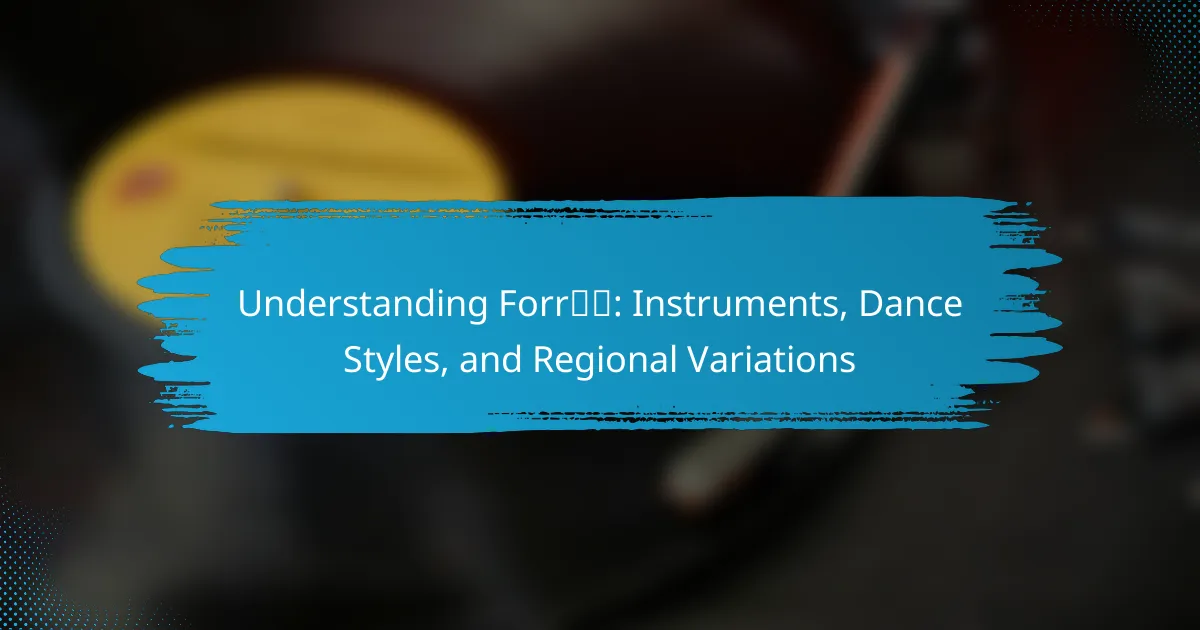Forró is a traditional Brazilian music and dance genre that originated in the northeastern region of Brazil in the early 20th century. It encompasses various musical styles, including baião, xote, and quadrilha, and is characterized by lively partner movements and footwork. Key instruments in Forró music include the accordion, zabumba, and triangle, which together create a distinctive sound essential for performances at festivals and social gatherings. The article explores different dance styles of Forró, such as Forró Pé de Serra, Forró Universitário, and Forró de Salão, highlighting their unique characteristics and cultural significance. Additionally, it provides guidance on effective learning methods for mastering Forró dance, emphasizing the importance of structured classes, practice, and community engagement.
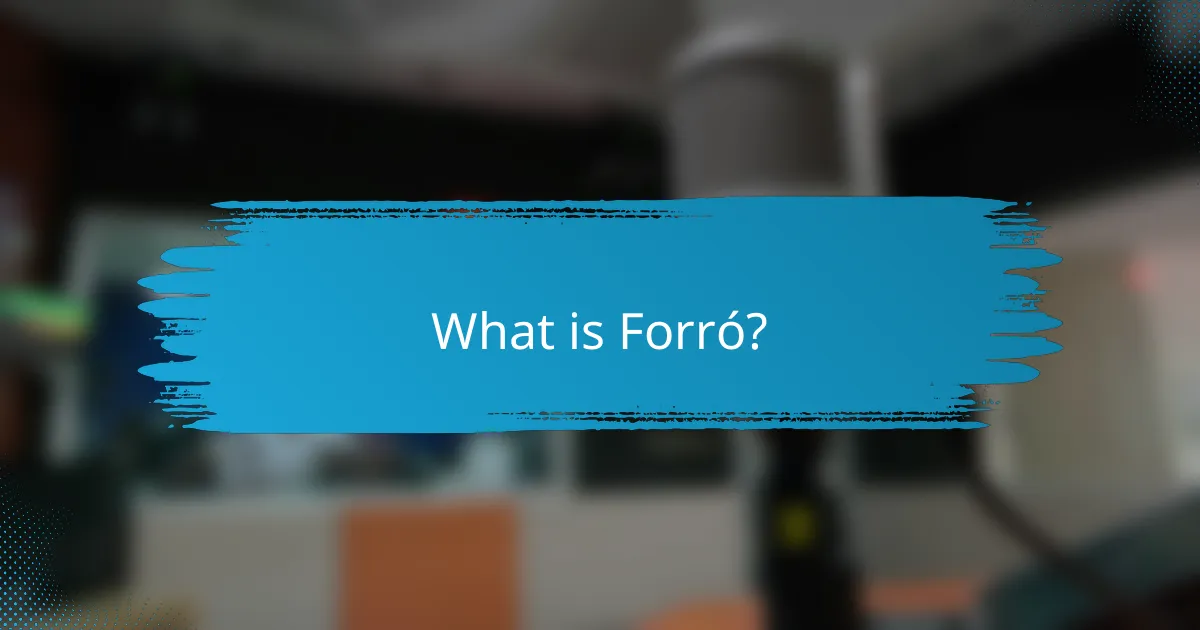
What is Forró?
Forró is a traditional Brazilian music and dance genre. It originated in the northeastern region of Brazil in the early 20th century. Forró combines various musical styles, including baião, xote, and quadrilha. The dance involves close partner movements and lively footwork. Instruments commonly used in forró include the accordion, zabumba, and triangle. Forró is often performed at festivals and social gatherings. It plays a significant role in Brazilian cultural identity. In recent years, forró has gained popularity beyond Brazil’s borders.
How did Forró originate?
Forró originated in the northeastern region of Brazil. Its roots trace back to the 19th century. The genre evolved from a blend of traditional folk music and dance. African, Indigenous, and European influences shaped its development. Initially, forró was performed at rural festivities and social gatherings. The accordion, zabumba, and triangle are key instruments in forró music. Over time, it gained popularity beyond rural areas. Today, forró is celebrated in various cultural events across Brazil.
What cultural influences shaped Forró?
Forró is shaped by diverse cultural influences, primarily from Indigenous, African, and European traditions. The Indigenous peoples contributed rhythmic patterns and instruments. African influences brought percussive elements and dance styles. European settlers introduced melodies, instruments like the accordion, and waltz rhythms. The combination of these elements created a unique musical genre. Forró evolved in the Northeast of Brazil, reflecting regional customs and celebrations. Its development was also influenced by the migration of people and cultural exchanges. Today, Forró is a symbol of Brazilian cultural identity, celebrated in festivals and social gatherings.
What historical events contributed to the development of Forró?
Forró developed from a blend of cultural influences in Brazil’s Northeast region. The arrival of European immigrants in the 19th century introduced new musical styles. African rhythms and dances also significantly shaped Forró’s evolution. The genre was popularized in the 1940s through radio broadcasts and dance halls. Major events like the São João festival further promoted Forró as a regional dance. The influence of traditional folk music, such as baião and xote, contributed to its unique sound. Over time, Forró became a symbol of regional identity and cultural pride in Brazil.
What are the key characteristics of Forró?
Forró is a traditional Brazilian music and dance genre. It originated in the northeastern region of Brazil. Key characteristics include the use of specific instruments like the accordion, zabumba, and triangle. The dance style is known for its close partner connection and lively movements. Forró music typically features a 2/4 or 4/4 rhythm. The genre encompasses various regional styles, including Pé de Serra and Universitário. Forró is often associated with festive gatherings and cultural celebrations. It has gained popularity beyond Brazil, influencing global dance and music scenes. The genre’s roots can be traced back to folk traditions and rural communities in Brazil.
What are the main instruments used in Forró?
The main instruments used in Forró are the accordion, zabumba, and triangle. The accordion provides the melodic foundation of the music. The zabumba, a type of drum, creates the rhythmic base. The triangle adds a distinctive percussive element to the sound. These instruments are essential for traditional Forró music. Their combination creates the lively and energetic atmosphere characteristic of the genre. Forró originated in the northeastern region of Brazil, where these instruments are commonly found. The accordion, in particular, has deep roots in Brazilian folk music.
How do the rhythms and melodies define Forró music?
Forró music is characterized by its distinct rhythms and melodies that define its style. The primary rhythm is marked by a strong, syncopated beat, typically played on the zabumba and triangle. This rhythmic foundation creates an energetic atmosphere conducive to dance. Melodies in Forró often feature the accordion, which adds a unique, emotive quality. The interplay between rhythm and melody creates a lively, engaging sound. This combination encourages participation and celebration in social settings. Forró’s roots in Brazilian folk traditions further enrich its rhythmic complexity and melodic diversity.
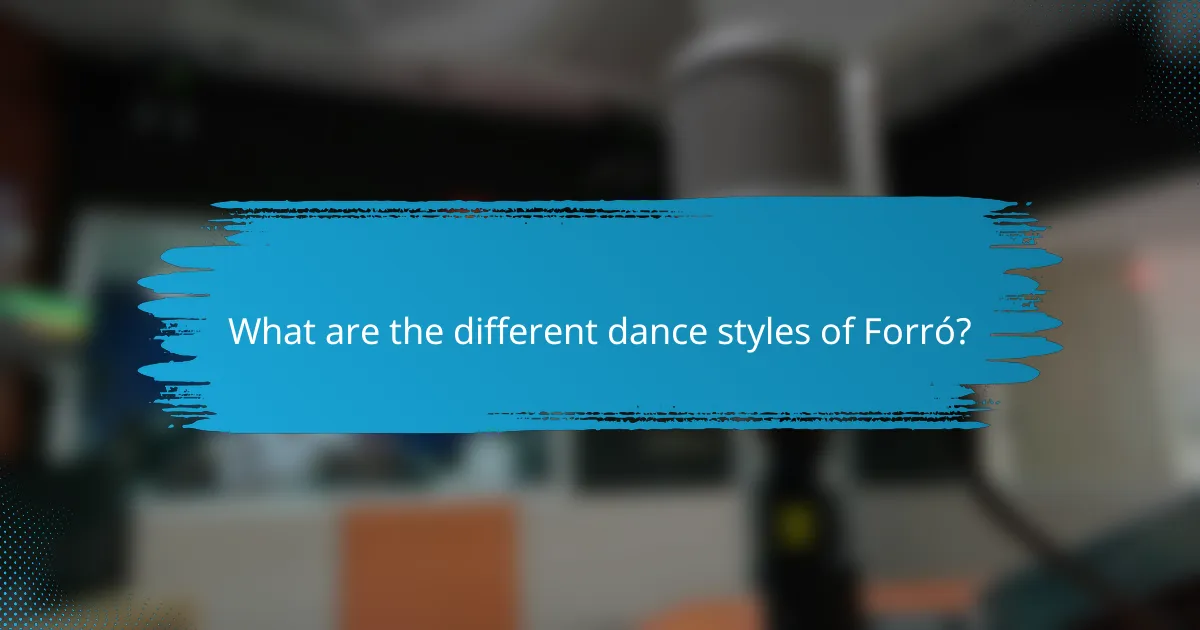
What are the different dance styles of Forró?
The different dance styles of Forró include Forró Pé de Serra, Forró Universitário, and Forró de Salão. Forró Pé de Serra is the traditional style, characterized by close partner dancing and simple steps. This style often features live accordion music and is popular at rural festivals. Forró Universitário emerged in urban areas, incorporating more complex steps and variations. It is often danced in a more freestyle manner. Forró de Salão is a ballroom style that emphasizes elegance and fluid movements. This style is often performed in dance schools and competitions. Each style reflects the cultural diversity and evolution of Forró across different regions.
What are the main dance styles within Forró?
The main dance styles within Forró are Forró Pé-de-Serra, Forró Universitário, and Forró de Salão. Forró Pé-de-Serra is characterized by its traditional roots and often features live accordion music. Forró Universitário incorporates modern influences and is popular among younger dancers. Forró de Salão emphasizes partner dancing and is usually performed in a social setting. These styles reflect the diverse cultural influences and regional variations of Forró throughout Brazil. Each style has distinct characteristics that cater to different audiences and occasions.
How do the dance styles differ in technique and movement?
Dance styles differ significantly in technique and movement. Forró emphasizes close partner connection and fluid body movements. The lead typically guides the follower through a series of spins and turns. In contrast, samba features more energetic footwork and rapid hip movements. The dancers often maintain a more open stance, allowing for individual expression. Ballet, on the other hand, focuses on precise body alignment and controlled movements. It requires a strong foundation in technique and often includes formal positions. Each style reflects its cultural origins, showcasing unique rhythms and patterns. For instance, forró is rooted in Brazilian folk traditions, while ballet has European classical roots. The diversity in these dance styles highlights the range of techniques and movements that define them.
What role does improvisation play in Forró dancing?
Improvisation plays a significant role in Forró dancing. It allows dancers to express their individuality and creativity. Each dancer can interpret the music in their unique way. This spontaneity enhances the connection between partners. Dancers often respond to the rhythm and mood of the music. The fluidity of movements reflects personal style and skill. Improvisation is essential for keeping the dance dynamic and engaging. It also fosters interaction between dancers, making each performance unique.
How does Forró dancing vary by region?
Forró dancing varies significantly by region in Brazil. In the Northeast, the style is often characterized by fast-paced movements and lively footwork. Dancers frequently incorporate elements from local culture and traditions. In contrast, the Southeast region tends to feature slower, more romantic styles. This variation reflects the diverse cultural influences present in each area. Additionally, the music accompanying Forró also differs regionally, impacting the dance style. For example, the use of different instruments can change the rhythm and feel of the dance. These regional differences highlight the rich tapestry of Forró as a cultural expression.
What are the regional variations in Forró dance styles?
Forró dance styles vary significantly across different regions of Brazil. In the Northeast, the traditional style emphasizes close partner connection and circular movements. In contrast, the Southeast showcases a more modernized version with influences from other dance forms. The style in the North is often characterized by lively footwork and improvisation. Each region also incorporates unique music rhythms, such as baião and xote, which influence dance movements. Additionally, local festivals and cultural practices shape these variations, creating a rich tapestry of Forró styles.
How do local traditions influence the way Forró is danced?
Local traditions significantly influence the way Forró is danced. Each region in Brazil has its own unique cultural practices that shape the dance style. For example, the dance incorporates local rhythms and movements. In the Northeast, traditional dances often include elements from indigenous and African cultures. These influences manifest in the footwork and body movements of dancers. Additionally, local festivals and celebrations dictate the social context of Forró dancing. The attire worn by dancers can also reflect regional customs. Overall, local traditions create diverse expressions of Forró across different areas.
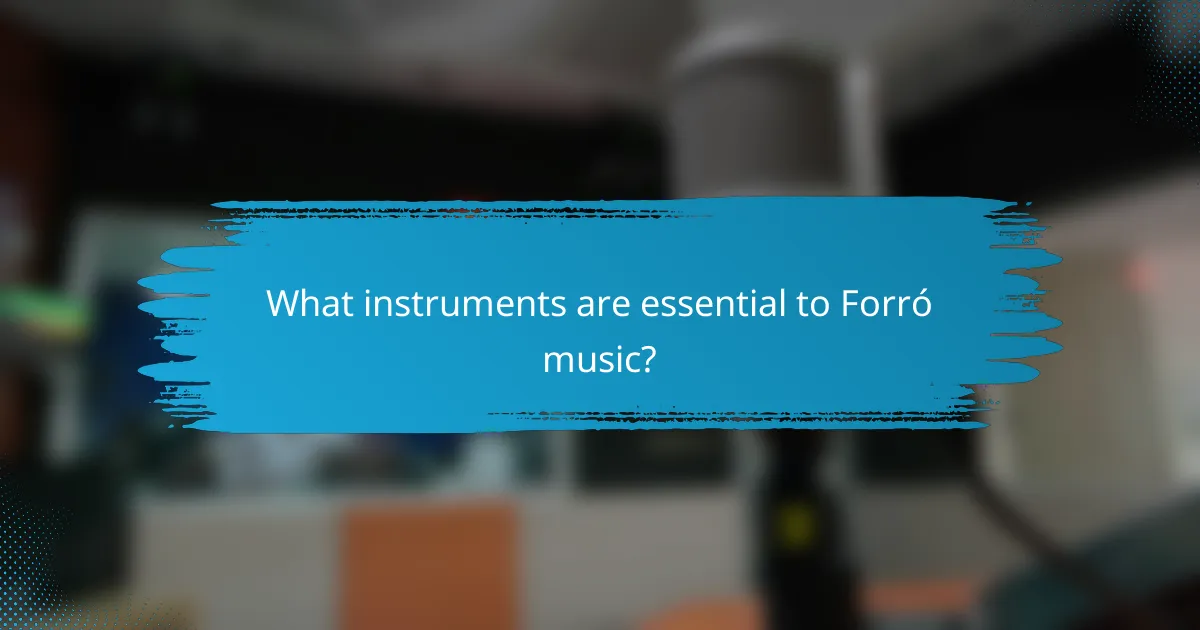
What instruments are essential to Forró music?
The essential instruments of Forró music include the accordion, zabumba, and triangle. The accordion serves as the primary melodic instrument, providing the distinctive sound of Forró. The zabumba is a bass drum that adds rhythm and depth to the music. The triangle contributes a sharp, metallic sound that complements the other instruments. These three instruments are foundational to the genre and create its unique musical texture. Their combination is crucial for traditional Forró performances, which often feature lively dance and community engagement.
What are the primary instruments used in Forró bands?
The primary instruments used in Forró bands are the accordion, zabumba, and triangle. The accordion provides the melodic foundation and is essential for the genre’s characteristic sound. The zabumba, a type of drum, adds rhythm and depth to the music. The triangle contributes a sharp, percussive element that enhances the overall texture. These instruments work together to create the lively and infectious sound typical of Forró. The combination of these three instruments is fundamental to the traditional Forró ensemble.
How does each instrument contribute to the overall sound of Forró?
The accordion, zabumba, and triangle are essential instruments in Forró. The accordion provides melodic lines and harmonies. It creates the primary musical theme for the dance. The zabumba delivers the rhythmic foundation. It combines bass and snare sounds to drive the tempo. The triangle adds accents and punctuates the rhythm. It enhances the overall texture of the music. Together, these instruments create a vibrant and lively sound characteristic of Forró. Each instrument’s role is crucial for maintaining the genre’s energetic feel.
What unique instruments are found in specific regional variations of Forró?
Unique instruments in regional variations of Forró include the sanfona, zabumba, and triangle. The sanfona, a type of accordion, is central to Forró music, especially in the northeastern states of Brazil. The zabumba, a bass drum, provides rhythmic support and is commonly used in various regional styles. The triangle, a percussion instrument, adds a distinct sound to the ensemble. In some areas, variations like the pandeiro and the guitarra are also incorporated, enhancing the local flavor of the music. Each instrument contributes uniquely to the overall sound, reflecting the cultural diversity within Forró.
How do these unique instruments enhance the regional sound?
Unique instruments enhance the regional sound of Forró by adding distinct tonal qualities and rhythms. Instruments like the accordion, zabumba, and triangle create a rich auditory tapestry. The accordion delivers melodic lines that are central to Forró music. The zabumba provides a strong rhythmic foundation, driving the dance tempo. The triangle adds sharp, punctuating accents that complement the other instruments. Together, these elements create a sound that is unmistakably tied to the cultural identity of the Northeast of Brazil. This regional sound is further enriched by the improvisational nature of performances, allowing for personal expression within the traditional framework.
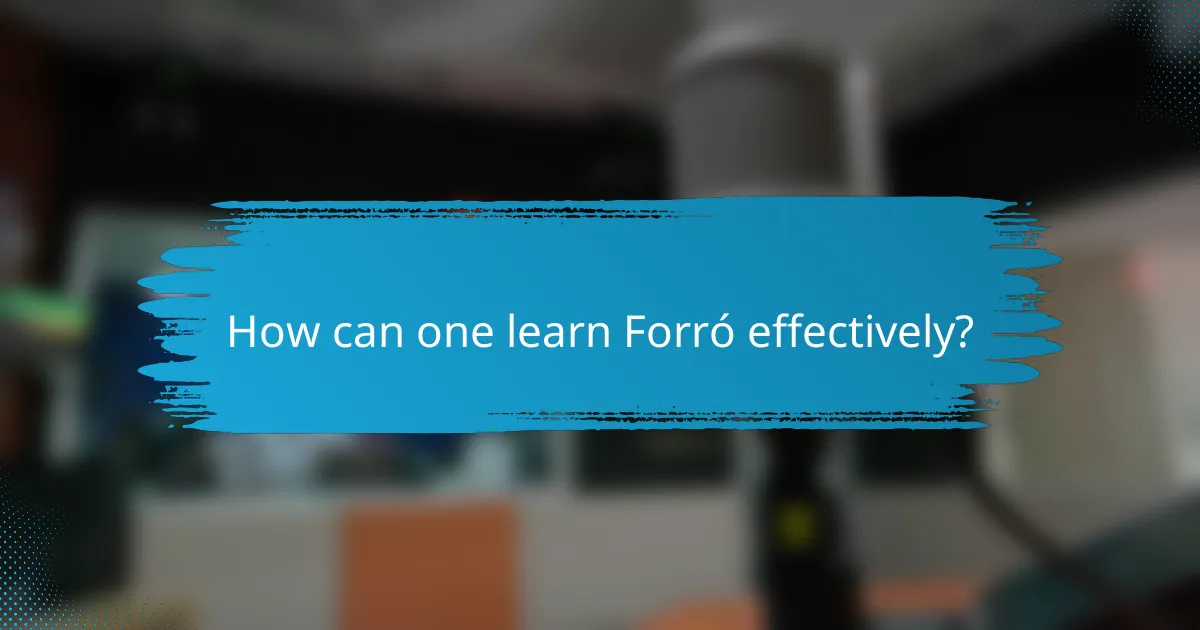
How can one learn Forró effectively?
To learn Forró effectively, one should take structured dance classes. These classes often provide foundational techniques and partner interaction skills. Practicing regularly is crucial for muscle memory and rhythm. Engaging with experienced dancers enhances learning through observation and feedback. Attending Forró events or festivals offers real-world experience and community engagement. Listening to Forró music helps internalize the rhythm and style. Online tutorials can supplement learning through visual demonstrations. Joining a local Forró group fosters a supportive environment for practice and improvement.
What are the best practices for beginners in Forró dancing?
Beginners in Forró dancing should focus on learning the basic steps and rhythm. It is essential to practice regularly to build muscle memory. Partner connection is crucial; maintaining a relaxed hold enhances the experience. Beginners should also pay attention to body posture and alignment. Listening to Forró music helps in understanding the dance’s tempo and style. Taking classes with experienced instructors provides valuable feedback. Additionally, observing experienced dancers can offer insights into techniques and styles. Lastly, enjoying the process fosters a positive learning environment.
How can one improve their Forró dancing skills over time?
To improve Forró dancing skills over time, consistent practice is essential. Regularly attending dance classes can enhance technique and confidence. Engaging with experienced dancers provides valuable feedback and tips. Practicing with a partner helps develop lead and follow skills. Watching videos of skilled Forró dancers can inspire and teach new moves. Participating in local dance events allows for real-world application of skills. Setting specific goals, such as mastering a particular step, can guide progress. Finally, maintaining a positive attitude fosters enjoyment and motivation in learning.
Forró is a traditional Brazilian music and dance genre originating from the northeastern region of Brazil, characterized by lively partner movements and specific instruments such as the accordion, zabumba, and triangle. The article explores the origins of Forró, its cultural influences from Indigenous, African, and European traditions, and the historical events that contributed to its development. Key characteristics of Forró music and dance styles, including Forró Pé de Serra, Universitário, and de Salão, are discussed, alongside regional variations and unique instruments that enhance its sound. Additionally, the article provides insights on effective learning practices for beginners and ways to improve dancing skills over time.
